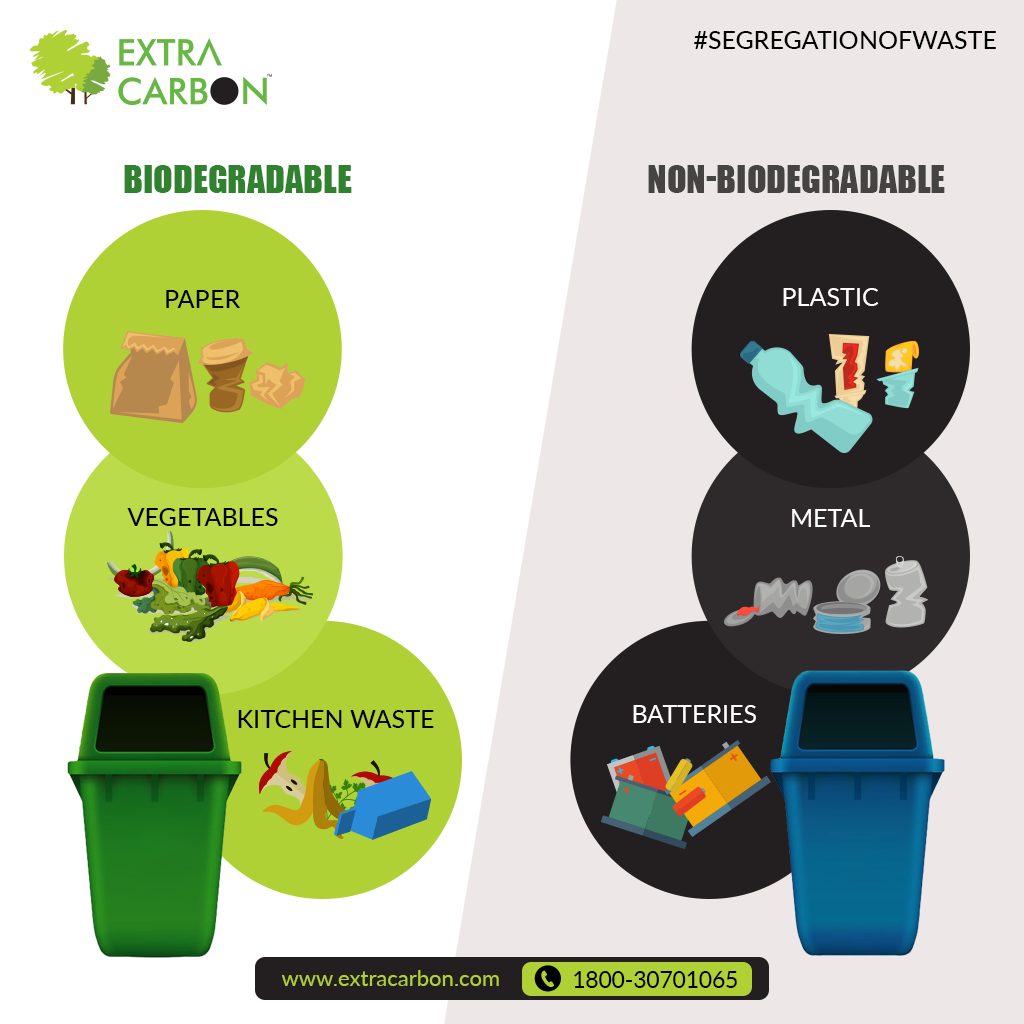We must actively manage biodegradable waste to uphold environmental sustainability, as it decreases the growth of landfills and other harmful dumping zones threatening all forms of life on earth. Understanding the difference between biodegradable and compostable is essential, as is recognizing examples of biodegradable waste and non-biodegradable waste.
Key Takeaways
- Biodegradable Waste are organic materials capable of natural decomposition, essential for reducing landfill impact.
- Biodegradables break down naturally; non-biodegradables persist and harm the ecosystem.
- Compostables require specific conditions to decompose; biodegradables break down over undetermined timescales.
- Effective biodegradable waste management showcases corporate responsibility and achieves sustainability goals.
- Regular audits and adjustments are necessary to keep pace with regulatory and technological changes.
What is Biodegradable Waste?
Organic waste that can naturally break down and enrich the soil is known as biodegradable waste. Environmental factors, like air, water, sunlight, oxygen as well as living organisms like bacteria and fungi, all play a role in this process. Examples of waste include leftover food (which presents opportunities for food waste upcycling), kitchen scraps, paper, human waste, manure, sewage sludge, and the remains of deceased animals.
On the other hand, non-biodegradable waste such as plastics, glass, and metals does not easily decompose through any natural means. These materials can persist in the environment for thousands of years while posing a threat to our planet and its inhabitants.
To highlight the distinction between non-biodegradable waste types further, let’s consider how long it takes items to decompose;
- Vegetables: Decompose in 5 days to 1 month.
- Paper: Breaks down in 2 to 5 months.
- Cotton T-shirt: Fully decomposes in about 6 months.
- Leather shoes: Takes 25 to 40 years to degrade.
- Nylon fabric: Biodegrades in 30 to 40 years.
In stark contrast, some non-biodegradable examples show even indefinite, decomposition times:
- Tin cans: Take 50 to 100 years to break down.
- Aluminium cans: Decompose in 80 to 100 years.
- Glass bottles: Endure for up to 1 million years.
- Plastic bags: Might persist for 500 years or perhaps never decompose.
Biodegradable vs Non-Biodegradable Waste
Biodegradable waste materials, as we have previously discussed, easily break down in the environment due to conditions and the activity of microorganisms. Examples of biodegradable waste include plant debris, vegetable peels, paper, and natural fabrics. These materials naturally decompose into components that act as organic fertilizer for the soil. Through this decomposition process, waste is transformed into elements like ozone and water without causing harm to the environment.
On the other hand, non-biodegradable waste, such as plastics, metals, and other inorganic materials do not decompose easily through biological processes. These non-biodegradable wastes persist on the Earth’s surface for periods of time. Contribute to issues such as ozone formation, air pollution, and water contamination. If not addressed promptly, these materials can have effects on both humans and animals.
Understanding Composability: Compostable vs Biodegradable
People often use the terms “composability” and “biodegradability” interchangeably, but they have distinct meanings and implications, especially in the context of waste management and environmental impact.
Compostable materials consist of organic substances that break down in a composting environment, producing nutrient-rich compost that enriches the soil. In contrast, biodegradable materials refer to any substances that natural processes and microorganisms break down over time.
A common misconception is that if a product is “biodegradable,” it will quickly and harmlessly disappear in any environment. However, “biodegradable” merely indicates that the material will break down at some point, without giving specifics on the time frame or the end products.
Likewise, just because an item is “compostable” doesn’t mean you can simply throw it in your backyard and expect it to become compost. For effective composting, materials need specific conditions, such as the right moisture, oxygen, and temperature levels. These conditions speed up the decomposition process, ensuring the resulting compost benefits plant life.
Biodegradable items decomposition can take anywhere from a few weeks to thousands of years. In contrast, compostable items typically decompose faster, often within a few months if placed in an appropriate composting facility.
In many areas, compostable items must meet specific standards, like breaking down in a commercial composting facility within a set period without leaving harmful residues. Always look for trusted certifications, such as the BPI (Biodegradable Products Institute) label in the U.S. when discerning the difference between compostable and biodegradable products. One of the critical points to remember is the importance of composting for businesses, as detailed by the Environmental Protection Agency.

The Business Imperative for Biodegradable Waste Management
Managing biodegradable waste is a crucial way for businesses to showcase responsibility, earn consumer trust, and achieve regulatory compliance. A growing number of businesses are integrating services like food waste recycling and food by-product waste services into their operations.
As sustainability targets like the United Nations’ Sustainable Development Goals (SDGs) gain traction, people expect businesses to make significant contributions. Actively managing biodegradable waste helps businesses align with these goals, especially in sustainable cities, responsible consumption, and life on land.
Effective waste management is not only a crucial aspect of maintaining regulatory compliance but also a strategic tool for businesses aiming for long-term sustainability and cost efficiency. One study highlighted this critical aspect, as mentioned on ScienceDirect.
Worldwide, regulations on waste management are becoming stricter. If businesses don’t comply, they risk facing legal consequences, including large fines and sanctions. Beyond the immediate financial penalties, non-compliance can also lead to restrictions or even the loss of operating licenses, restricting their market presence.
Identifying and Classifying Biodegradable Waste
To ensure an environmentally friendly footprint, you must accurately identify and classify waste. Here are some tips for precise categorization and its importance:
- Identify organic materials that naturally decompose, such as food scraps, wooden items, and natural cloth. These are examples of biodegradable waste.
- Most items made of plastics (unless labelled as biodegradable or compostable), metals, and glass is non-biodegradable. Always check labels and product descriptions to verify.
- Recognize recyclable products by the symbols they carry.
- In both household and business environments, education is vital. Consistently train your staff members on proper categorization guidelines.
By classifying waste correctly, you ensure that each waste type undergoes the best processing method, whether it’s composting, recycling, or landfill disposal. This approach minimizes environmental damage and supports a circular economy.
On the other hand, improper disposal might result in legal consequences, particularly for businesses. Correct categorization guarantees you adhere to local waste management regulations, reducing the risk of fines or sanctions.
Planning Biodegradable Waste Management
Effective waste management isn’t just a crucial operational task; it’s a strategic priority. Businesses must plan with foresight to not only comply with regulations but also to use waste management for long-term sustainability and cost efficiency. Here are the steps to plan waste management successfully:
Assessing Your Biodegradable Waste Stream
To manage waste effectively, businesses need to understand the nature and volume of the waste they produce. Here’s what businesses should do:
- Identify Types and Volumes: Carry out a systematic assessment to pinpoint the various types of biodegradable waste you generate, such as food waste, yard waste, or paper waste.
- Perform a Waste Audit: Collect waste over a set period, categorize it, and then analyze its composition. The insights from this audit give a comprehensive view of the waste stream and guide targeted management strategies.
Setting Realistic Waste Reduction Goals
Committing to waste reduction goals is essential for sustainability and operational efficiency:
- Minimize Environmental Footprint: Waste reduction conserves resources and decreases landfill volumes.
- Adopt SMART Goals: Businesses should establish goals that are Specific, Measurable, Achievable, Relevant, and Time-bound. This approach ensures clarity and improves the likelihood of success.
Choosing the Right Waste Management Partners
The choice of specialized waste management companies is critical:
- Advantages of Specialized Partners: Firms like Shapiro offer expertise, experience, and cutting-edge tools to enhance waste management.
- Uncover Cost-saving Opportunities: The expertise of such partners reveals potential ways to cut waste management costs.
Implementing Waste Segregation and Collection Systems
Effective waste management starts at the disposal point:
- Use Clearly Labelled Bins: Designate bins for specific waste types (biodegradable, recyclable, etc.) and label them clearly.
- Schedule Regular Collection: A routine waste collection schedule prevents build-up and ensures prompt processing.
Exploring Composting and Recycling Options
Transforming waste into resources promotes sustainability:
- Recycle Biodegradable Waste: Businesses can recycle some biodegradable materials, like paper, which lessens the need for raw materials.
- Implement Solutions: Look for local composting facilities, consider on-site composting options, or engage in community recycling programs.
Monitoring and Adjusting the Plan
Waste management requires continuous attention:
- Monitor Continuously: Conducting regular audits evaluates the current plan’s effectiveness and identifies improvement areas.
- Stay Informed: As regulations evolve and new technologies and best practices emerge, businesses must stay updated and adapt their strategies accordingly.
Effective waste management is not only a crucial aspect of maintaining regulatory compliance but also serves as a strategic tool for businesses aiming for long-term sustainability and cost efficiency. By understanding and categorizing biodegradable waste streams, setting realistic reduction targets, partnering with expert waste management entities, implementing proper segregation systems, and embracing composting and recycling solutions, businesses can significantly minimize their environmental footprint.
This is where Shapiro coming into play. With our deep expertise in waste management and recall logistics, we are your trusted partner in navigating this challenging terrain. Our nationwide network of qualified partners ensures a swift and efficient recall process.
Let us help you safeguard your brand and, more importantly, the pets who depend on your products.
Baily Ramsey, an accomplished marketing specialist, brings a unique blend of anthropological insight and marketing finesse to the digital landscape. Specializing in educational content creation, she creates content for various industries, with a particular interest in environmental initiatives.
